Bosnia and Herzegovina in the Middle Ages
The history of Bosnia and Herzegovina in the Middle Ages refers to the time period between the Roman era and the 15th-century Ottoman conquest. The Early Middle Ages in the Western Balkans saw the region reconquered from barbarians (Ostrogoths) by the Byzantine Emperor Justinian I, followed by raids and migrations carried out by Slavic peoples in the 6th and 7th centuries. The first mention of a distinct Bosnian region comes from the 10th-century Byzantine text De Administrando Imperio. By the late 9th and early 10th century, Latin priests had Christianized much of Bosnia, with some areas remaining unconverted. In the High Middle Ages, Bosnia experienced economic stability and peace under the Ban Kulin who ruled over Banate of Bosnia from 1180 to 1204 and strengthened its ties with the Republic of Ragusa and with Venice. The Kingdom of Bosnia emerged in the Late Middle Ages (1377). The kingdom faced internal and external conflicts, eventually falling under Ottoman rule in the late 15th and early 16th centuries.

Franciscan monasteries in 15th century Bosnia.
Kulin was the Ban of Bosnia from 1180 to 1204, first as a vassal of the Byzantine Empire and then of the Kingdom of Hungary, although his state was de facto independent. He was one of Bosnia's most prominent and notable historic rulers and had a great effect on the development of early Bosnian history. One of his most noteworthy diplomatic achievements is widely considered to have been the signing of the Charter of Ban Kulin, which encouraged trade and established peaceful relations between Dubrovnik and his realm of Bosnia. His son, Stephen Kulinić succeeded him as Bosnian Ban. Kulin founded the House of Kulinić.
Ban Kulin
Copy B of the Charter of Ban Kulin.



